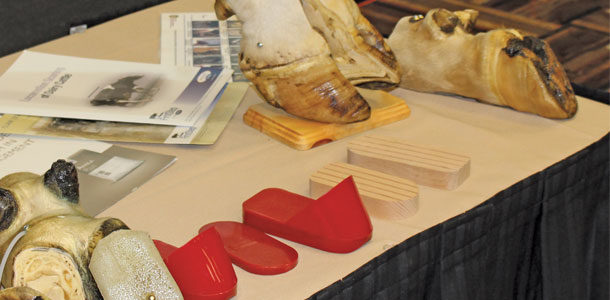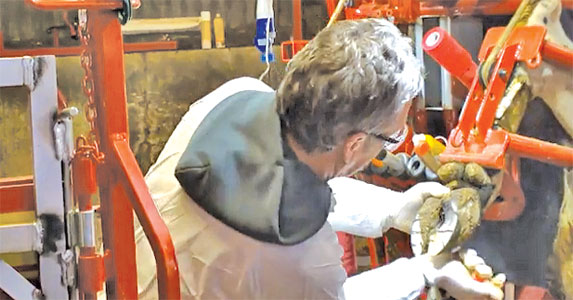As dairy farmers, you try to do everything you can to keep your cows comfortable, clean and healthy. Even still, there are things you wish you could do differently – and maybe you would if you had the time, help or money. Sound familiar?
It’s true; there are things on the farm that are important but might not be your priority. If hoof care isn’t at the top of your list, Karl Burgi would say you need to get your priorities straight.
“If you want to be successful, you need to treat lame cows,” says Burgi, founder of Sure Step Consulting International LLC.
Burgi is a consultant, teacher, trimmer, product designer and overall master of all things related to cattle hoof care. He also travels the globe speaking to farmers about the importance of healthy hooves. This past January, Burgi spoke to a standing-room-only audience at the Leading Producer Conference, January 6-7 in Wisconsin Dells, Wisconsin.
“I have a unique perspective but also a responsibility to do everything in my power to keep cows productive and in the herd as long as possible. My business philosophy and personal mission is to save cows,” says Burgi via his website.
Burgi is so serious about hoof care that the phrase “save cows” is a registered trademark.
From his presentation, maintaining healthy hooves can be broken down into three main themes: Find lameness problems early, treat problems with consistency and take steps to create a hoof-friendly environment.
Early diagnosis
To diagnose and ultimately treat hoof problems, it’s important to know what to look for. Most dairy cattle with hoof problems suffer from a combination of long toes, hairy heel warts (digital dermatitis) and abscesses (also known as ulcers).
“Ninety-five percent of all lesions are in the rear limbs,” Burgi says. “You want to keep weight on the toes; as soon as weight shifts to the rear of the hoof, trauma can occur.”
In addition to watching for physical signs of lameness such as hoof angle and obvious favoring of a limb, Burgi suggests keeping an eye on transition cows (both cows and heifers). Heat is also a contributing factor to lameness. Any sort of stress can lead to lameness, and it likely won’t show up for 45 to 60 days following the trigger period.
How can you tell if a cow is in the early stages of lameness? Burgi uses locomotion scoring to place numeric values on lameness based on visual indicators of movement.
He also encourages observing cow behavior for warning signs. If cows favor lying down instead of eating or moving from place to place, there could be a problem brewing, and it might be time to check her hooves. Taking note of these behavior changes immediately before and after calving is especially critical.
Treat, block, repeat
Once a cow has been identified as having a hoof problem, it’s important to treat her as soon as possible.
“All sole ulcers need to be blocked,” Burgi says. “The quicker you put a block on, the quicker she will recover.”
Ideally, a hoof trimming professional should treat the sore toe and attach a wooden or plastic block to the opposing healthy toe to redistribute weight and keep the area clean. In the absence of a hoof trimmer, farmers can learn to treat cows that have problems in between visits.
“Blocks save cows and put milk in the tank,” Burgi says.
In as little as 12 days, a cow can recover, if treated properly. However, Burgi recommends keeping all blocks on for five to six weeks.
For digital dermatitis, more commonly known as hairy heel warts, early detection and treatment is key. Burgi urges farmers to cleanse the area and then treat heel warts with a topical antibiotic and wrap the hoof at the first signs of infection.
“I can wrap four to five feet per roll of wrap. Make sure not to use too much,” Burgi says. “The wrap should be removed after 24 hours (if it doesn’t fall off on its own).”
Creating an environment with feet in mind
“Standing cows have a greater risk for trauma,” Burgi says. “With [cows on pasture] you don’t see sole ulcers.”
Modern confinement facilities have been designed to be comfortable for cows – and they are, but the bottom line is that certain aspects are better for the farmer than the cow. Burgi isn’t suggesting all cows should be on pasture – pasture has its own set of problems, too – but some cement floors can be killers on hooves.
Slippery, rough and slatted floors can lead to hoof trauma. The ideal floor has grooves about 3 inches apart with a narrow, shallow groove opening.
Sand is also critical in maintaining healthy hooves. Keeping coarse sand in a freestall barn might be less expensive, but any saving will surely go out the window with hoof problems. Burgi suggests fine sand that is free of any pebbles and debris.
To treat and prevent heel warts, a footbath is the best option. There are several footbath solutions on the market, and a simple copper sulfate is a safe, all-weather product.
To prevent cattle from stopping or defecating as they pass through the footbath, Burgi suggests a footbath with sidewalls.
“Use a footbath with high sidewalls, and the cows won’t stop until they see daylight,” Burgi says.
Lameness happens
On a dairy farm, cows are going to get lame, but with proper treatment, they can recover.
“Lame cows take time,” Burgi says. “Lameness is widely accepted, and you can’t tolerate it if you want to be successful.”
Healthy hooves result from knowing what to look for, taking action to treat problems and making sure facilities are designed with comfort and cleanliness in mind. Most importantly, working with a trained hoof trimmer who visits the farm on a routine basis will help herds of all sizes maintain healthy hooves and keep milk in the tank. PD
For more information on Karl Burgi and his services, courses and products, visit the Save Cows website.
Maria F. McGinnis is a freelance writer based in Sun Prairie, Wisconsin.
PHOTOS
TOP: Burgi believes that using wooden and plastic blocks to relieve the pressure of a sore toe is the only way a cow will recover from a toe ulcer.
BOTTOM: Karl Burgi is an internationally known hoof health expert, shown here at a training event. Burgi demonstrates hoof maintenance for healthy cows – not just those with hoof problems. Photos courtesy of Maria F. McGinnis.







